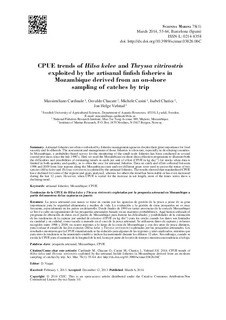CPUE trends of Hilsa kelee and Thryssa vitrirostris exploited by the artisanal finfish fisheries in Mozambique derived from an on-shore sampling of catches by trip
Journal article, Peer reviewed
Permanent lenke
http://hdl.handle.net/11250/194898Utgivelsesdato
2014-03Metadata
Vis full innførselSamlinger
- Articles [3012]
Originalversjon
Cardinale M., Chacate O., Casini M., Chaúca I., Vølstad J.H. 2014. CPUE trends of Hilsa kelee and Thryssa vitrirostris exploited by the artisanal finfish fisheries in Mozambique derived from an on-shore sampling of catches by trip. Sci. Mar. 78(1): 55-64. doi: http://dx.doi.org/10.3989/scimar.03826.06C 10.3989/scimar.03826.06CSammendrag
Artisanal fisheries are often overlooked by fisheries management agencies despite their great importance for food security and livelihoods. The assessment and management of those fisheries is often rare, especially in developing countries. In Mozambique, a probability-based survey for the monitoring of the small-scale fisheries has been conducted in several coastal provinces since the late 1990’s. Here we used the Mozambican on-shore data collection programme to illustrate both the difficulties and possibilities of estimating trends in catch per unit of effort (CPUE in kg day–1) for stocks when data is limited in both quantity and quality, as is often the case for artisanal fisheries. Data on catch and effort collected between 1998 and 2009 from four regions along the Mozambican coast and two different gears were used to assess the status of two species (Hilsa kelee and Thryssa vitrirostris) exploited by the artisanal fisheries. The results showed that standardized CPUE have declined for some of the regions and gears analysed, whereas for others the trend has been stable or has even increased during the last 12 years. However, when CPUE is scaled for the increase in net length, most of the times series show a declining trend.
